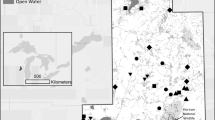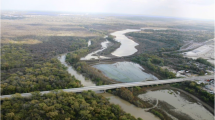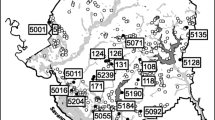Abstract
Worldwide, interest is growing in the reliability of using macroinvertebrates as wetland condition indicators and for signaling restoration or mitigation success. We compared macroinvertebrate community structure and environmental parameters of reference sites to restoration sites, representing re-establishment and enhancement techniques. To determine which environmental parameters are suitable indicators of macroinvertebrate community metrics (i.e., taxon richness, diversity and evenness), we compared macroinvertebrate communities with a suite of environmental and habitat variables, such as standing water duration, dissolved oxygen (DO) content, pH, and vegetation cover by stand height or growth form. Data were collected from 16 wetland sites in four categories: 4 re-establishment, 4 enhancement, and 4 of each closed or open canopy reference. Each year for two years, hydrology, water quality, and vegetation attributes were sampled at each site, along with macroinvertebrate community sampling. Vegetation variables were primary drivers of macroinvertebrate community metrics. Though DO was positively correlated with macroinvertebrate taxa evenness, multiple vegetation variables were strongly related to taxa evenness. Sites supporting higher macroinvertebrate richness and diversity had longer inundation times, more coverage of filamentous algae, and fewer dominant tree species. If providing habitat supportive of macroinvertebrate taxon richness and diversity are restoration goals, then appropriate mitigation designs should incorporate heterogeneous mixtures of habitat types ranging from open to partially closed canopies which influence inundation duration, DO, and algal cover. Further, our results suggest that a suite of vegetation variables in conjunction with hydrology have potential to be used as proxies for assessing wetland macroinvertebrate community metrics.







Similar content being viewed by others
Data availability
The datasets generated during and/or analyzed during the current study are available from the corresponding author on reasonable request.
References
Ambrose RF (2000) Wetland mitigation in the United States: assessing the success of mitigation policies. Wetlands Australia 19:1–27
Balcombe CK, Anderson JT, Fortney RH, Kordek WS (2005) Aquatic macroinvertebrate assemblages in mitigated and natural wetlands. Hydrobiologica 541:175–188
Batzer DP, Palik BJ, Beuch R (2004) Relationships between environmental characteristics and macroinvertebrate communities in seasonal woodland ponds of Minnesota. J N Am Benthol Soc 23:50–68
Batzer DP, Shurtleff AS, Rader RB (2001) Sampling invertebrates in wetlands. In: Rader RB, Batzer DP, Wissinger SA (eds) Bioassessment and management of North American freshwater wetlands. John Wiley and Sons, New York, pp 339–354
Batzer DP, Taylor BR, DeBiase AE, Brantley SE, Schultheis R (2015) Response of aquatic invertebrates to ecological rehabilitation of southeastern USA depressional wetlands. Wetlands 35:803–813
Bray JR, Curtis JT (1957) An ordination of upland forest communities of southern Wisconsin. Ecol Monogr 27:325–349
Breaux A, Serefidden F (1999) Validity of performance criteria and a tentative model for regulatory use in compensatory wetland mitigation permitting. Environ Manag 24:327–336
Brooks RP, Wardrop DH, Cole CA, Campbell DA (2005) Are we purveyors of wetland homogeneity? A model of degradation and restoration to improve wetland mitigation performance. Ecol Eng 24:331–340
Brown SC (1999) Vegetation similarity and avifaunal food value of restored and natural marshes in northern New York. Restor Ecol 7:56–68
Brown SC, Batzer DP (2001) Birds, plants, and macroinvertebrates as indicators of restoration success in New York marshes. In: Rader RB, Batzer DP, Wissinger SA (eds) Bioassessment and management of North American freshwater wetlands. Wiley, New York, pp 237–248
Bunn SE, Boon PI (1993) What sources of organic carbon drive food webs in billabongs? A study based on stable isotope analysis. Oecologia 96:85–94
Burton TM, Stricker CA, Uzarski DG (2002) Effects of plant community composition and exposure to wave action on invertebrate habitat use of Lake Huron coastal wetlands. Lakes Reserv Res Manag 7:255–269
Cheal F, Davis JA, Growns JE, Bradley JS, Whittles FH (1993) The influences of sampling method on the classification of wetland macroinvertebrate communities. Hydrobiologia 257:47–56
Clarke KR (1993) Non-parametric multivariate analysis of changes in community structure. Aust J Ecol 18:117–143
Daniel J, Rooney RC (2021) Wetland hydroperiod predicts community structure, but not the magnitude of cross-community congruence. Sci Rep 11:429
DeBerry DA, Matthews JW (2015) Trends in floristic quality assessment for wetland evaluation. Wetland Sci Practice 32:12–22
DeBiase AE, Taylor BE (2005) Microcrustaceans (Branchiopoda and Copepoda) of wetland ponds and impoundments on the Savannah River Site, Aiken, South Carolina. SRO-NERP-28. Savannah River Ecology Laboratory, Aiken
Denson D (undated) Changes in the macroinvertebrate community of a central Florida herbaceous wetlands over a twelve-month period. Florida Department of Environmental Protection. 44 pp.
DeSzalay F, Resh V (2008) Factors influencing macroinvertebrate colonization of seasonal wetlands: responses to emergent plant cover. Freshw Biol 45:295–308
Dodson SI (2001) Zooplankton communities of restored depressional wetlands in Wisconsin USA. Wetlands 21:292–300
Epele LB, Miserendino ML (2015) Environmental quality and aquatic invertebrate metrics relationships at Patagonian wetlands subjected to livestock grazing pressures. PLoS ONE e0:10137873
Euliss NH, Wrubleski DA, Mushet DM (1999) Wetlands of Prairie Pothole Region: invertebrate species composition, ecology, and management. In: Batzer DP, Rader RB, Wissinger SA (eds) Invertebrates in freshwater wetlands of North America: ecology and management. Wiley, New York, pp 471–514
Evans DL (1996) Aquatic macroinvertebrate communities of constructed and natural marshes in central Florida. Ph.D. Dissertation, University of Florida, Gainesville, FL
Fritz KM, Johnson BR, Walters DM (2006) Field operations manual for assessing the hydrologic permanence and ecological condition of headwater streams. PA/600/ R-06/126. U.S. Environmental Protection Agency, Office of Research and Development, Washington DC.
Frost C (1995) Presettlement fire regimes in southeastern marshes, peatlands and swamps. Proceedings, Tall Timbers fire ecology conference; 1993 November 3-6. Tall Timbers Research Station, Tallahassee, FL, vol. 19, pp 39–60
Gianopulos K (2014) Coefficient of Conservatism database development for wetland plants occurring in the Southeast United States. North Carolina Department of Environment & Natural Resources, Division of Water Resources: Wetlands Branch. Report to the EPA Region 4
Gleason JE, Bortolotti JY, Rooney RC (2018) Wetland microhabitats support distinct communities of aquatic macroinvertebrates. J Freshw Ecol 33:73–82
Golladay SW, Taylor BW, Palik BJ (1997) Invertebrate communities of forested limesink wetlands in southwest Georgia, USA: habitat use and influence of extended inundation. Wetlands 17:383–393
Halverson MA, Skelly DK, Kiesecker JM, Freidenburg LK (2003) Forest mediated light regime linked to amphibian distribution and performance. Oecologia 134:360–364
Hammer Ø, Harper DAT, Ryan PD (2001) PAST: paleontological statistics software package for education and data analysis. Palaeontol Electron 4:9
Hartzell D, Bidwell JR, Davis CA (2007) A comparison of natural and created depressional wetlands in central Oklahoma using metrics from indices of biological integrity. Wetlands 27:794–805
Hill T, Kulz E, Munoz B, Dorney J (2013) Compensatory stream and wetland mitigation in North Carolina: an evaluation of regulatory success. Environ Manag 51:1077–1091
Hough P, Harrington R (2019) Ten years of the compensatory mitigation rule: reflections on progress and opportunities. Environmental Law Reporter:49 ERL 10018
Hussain QA, Pandit AK (2012) Macroinvertebrates in streams: a review of some ecological factors. Int J Fisher Aquacul 4:114–123
IBM Corp Released (2011) IBM SPSS Statistics for Windows, Version 20.0. IBM Corp, Armonk, NY
Jessop J, Spyreas G, Pociask GE, Benson TJ, Ward MP, Kent AD, Matthews JW (2015) Tradeoffs among ecosystem services in restored wetlands. Biol Cons 191:341–348
King RS, Richardson CJ (2002) Evaluating subsampling approaches and macroinvertebrate taxonomic resolution for wetland bioassessment. J N Am Benthol Soc 21:150–171
Kolozsvary MB, Holgerson MA (2016) Creating temporary pools as wetland mitigation: how well do they function? Wetlands 36:335–345
Kornijów R, Gulati RD, Ozimek T (1995) Food preference of freshwater invertebrates: comparing fresh and decomposed angiosperm and a filamentous alga. Freshw Biol 33:205–212
Lenat D (1988) Water quality assessment of streams using a qualitative collection method for benthic macroinvertebrates. J N Am Benthol Soc 7:222–233
Lillie RA (2003) Macroinvertebrate community structure as a predictor of water duration in Wisconsin wetlands. J Am Water Resour Assoc 39:389–400
Marchetti MP, Garr M, Smith ANH (2010) Evaluating wetland restoration success using aquatic macroinvertebrate assemblages in the Sacramento Valley, California. Restor Ecol 18:457–466
Matthews JW, Endress AG (2007) Performance criteria, compliance success, and vegetation development in compensatory mitigation wetlands. Environ Manag 41:130–141
Meyer CK, Whiles MR (2008) Macroinvertebrate communities in restored and natural Platte River slough wetlands. J N Am Benthol Soc 27:626–639
Morrison WR, Bohlen PJ (2010) Influence of vegetation on invertebrate communities in grazed freshwater wetlands in south-central Florida. Southeast Nat 9:453–464
National Research Council (NRC) (2001) Compensating for wetland losses under the Clean Water Act. National Academy Press, Washington, DC, p 348
Natural Resources Conservation Service (NRCS) (2016) Field Office Technical Guide. Section II—Climate Data—AgACIS (Agricultural Applied Climate Information System). Accessed at https://efotg.sc.egov.usda.gov/efotg_locator.aspx
NC Department of Environment and Natural Resources, Division of Water Quality, Biological Assessment Unit (NC DWQ) (2012) Standard operating procedures for benthic macroinvertebrates. Accessed at http://portal.ncdenr.org/c/document_library/get_file?uuid=f3cfa483-16de-4c18-95b7-93684c1b64aa&groupId=38364
Petranka JW, Holbrook CT (2006) Wetland restoration for amphibians: should local sites be designed to support metapopulations or patchy populations? Restor Ecol 14:404–411
Plenzler MA (2012) Terrestrial influences on the macroinvertebrate biodiversity of temporary wetlands. Dissertation. Graduate College of Bowling Green State University
Rader RB, Batzer DP, Wissinger SA (2001) Bioassessment and management of North American freshwater wetlands. Wiley, New York, p 469
Resh VH, Unzicker JD (1975) Water quality monitoring and aquatic organisms: the importance of species identification. J Water Pollut Control Feder 47:9–19
Sartori L, Canobbio S, Cabrini R, Fornaroli R, Mezzanotte V (2015) Macroinvertebrate assemblages and biodiversity levels: ecological role of constructed wetlands and artificial ponds in a natural park. J Limnol 72:335–345
Schiesari L (2006) Pond canopy cover: a resource gradient for anuran larvae. Freshw Biol 51:412–423
Schneider DW (1999) Snowmelt pond in Wisconsin: Influence of hydroperiod on invertebrate community structure. In: Batzer DP, Rader RB, Wissinger SA (eds) Invertebrates in freshwater wetlands of North America: ecology and management. Wiley, New York, pp 299–318
Shannon C (1948) A mathematical theory of communication. Bell Syst Tech J 27:379–423
Sharitz RR, Batzer DP (1999) An introduction to freshwater wetlands in North America and their invertebrates. In: Batzer DP, Rader RB, Wissinger SA (eds) Invertebrates in freshwater wetland of North America: ecology and management. Wiley, New York, pp 1–22
Sharma RC, Rawat JS (2009) Monitoring of aquatic macroinvertebrates as bioindicator for assessing the health of wetlands: a case study in the Central Himalayas, India. Ecol Ind 9:118–128
Sheldon CJ, Ficklin RL, Fawley KP, Fawley MW, Bataineh M, Nelson AS, Wilson S (2016) Vegetation diversity in natural and restored forested wetland sites in southeast Arkansas. J Arkansas Acad Sci 70:37
Simpson EH (1949) Measurement of diversity. Nature 163:688
Skelly DK, Werner EE, Cortwright SA (1999) Long-term distributional dynamics of a Michigan amphibian assemblage. Ecology 80:2326–2337
Sprecher SW (2000) Installing monitoring wells/piezometers in wetlands. Environmental Laboratory Engineer Research and Development Center. US Army Corps of Engineers Technical Note ERDC TN-WRAP-00-02
Steel A (2013) An analysis of the North Carolina Wetland Assessment Method (NCWAM) using Quantitative Metrics. Master’s Thesis, NC State University
Sueltenfuss JP, Cooper DJ (2019) Hydrologic similarity of reference wetlands does not lead to similar plant communities in restored wetlands. Restor Ecol 27:1137–1144
Taft JB, Wilhelm GS, Ladd DM, Masters LA (1997) Floristic quality assessment for vegetation in Illinois, a method for assessing vegetation integrity. Erigenia 15:3–95
Tarr TL, Baber MJ, Babbitt KJ (2005) Macroinvertebrate community structure across a wetland hydroperiod gradient in southern New Hampshire, USA. Wetlands Ecol Manag 13:321–334
Van den Bosch K, Matthews JW (2017) An assessment of long-term compliance with performance standards in compensatory mitigation wetlands. Environ Manag 59:546–556
Wetzel RG (1983) Limnology, 2nd edn. Harcourt Brace College Publishers, New York, p 439
Wiggins GB, Mackay RJ, Smith IM (1980) Evolutionary and ecological strategies of animals in annual temporary pools. Arch Hydrobiol Suppl 58:97–206
Xu M, Zhaoyin W, Duan X, Pan B (2014) Effects of pollution on macroinvertebrates and water quality bio-assessment. Hydrobiologia 1:247–259
Zimmer KD, Hanson MA, Butler MG (2000) Factors influencing invertebrate communities in prairie wetlands: a multivariate approach. Can J Fish Aquat Sci 57:76–85
Acknowledgements
The authors wish to especially thank Larry Eaton, who is a published aquatic macroinvertebrate biologist, retired from the NC Department of Environmental Quality (NC DEQ), and listed as a taxonomic expert with the Society for Freshwater Science. He assisted with sampling and identified the many thousands of macroinvertebrates. James Graham, Anthony Scarbraugh, Lori Montgomery, and Michael Coleman provided field assistance. Amanda Mueller, Ross Vander Vorste, Larry Eaton, and Cyndi Karoly provided valuable reviews of the final project report. Philip Cross and Peter Ibsen assisted with figures. The authors also wish to thank two anonymous reviewers whose feedback improved the manuscript. This project was funded in part by the United States Environmental Protection Agency (US EPA) under assistance agreement CD-00D01512 to the NC DEQ. The contents of this document do not necessarily reflect the views and policies of the US EPA, nor does the US EPA endorse trade names or recommend the use of commercial products mentioned in this document.
Funding
This work was funded by the US EPA Wetland Program Development Grant CD-00D01512 and the North Carolina Department of Environmental Quality.
Author information
Authors and Affiliations
Contributions
KG, VB, and GR designed the study, collected and analyzed data, and KG wrote a report to the US EPA, which served as the basis for this publication. SS and KG reanalyzed data, wrote, and edited this work for the formatted journal manuscript.
Corresponding author
Additional information
Publisher's Note
Springer Nature remains neutral with regard to jurisdictional claims in published maps and institutional affiliations.
Kristie Gianopulos and Sheri Shiflett joint first-author.
Supplementary Information
Below is the link to the electronic supplementary material.
Rights and permissions
About this article
Cite this article
Gianopulos, K., Shiflett, S., Baker, V. et al. Aquatic macroinvertebrate communities in relation to environmental variables in restoration and reference wetlands in North Carolina, USA. Wetlands Ecol Manage 29, 823–841 (2021). https://doi.org/10.1007/s11273-021-09812-w
Received:
Accepted:
Published:
Issue Date:
DOI: https://doi.org/10.1007/s11273-021-09812-w




